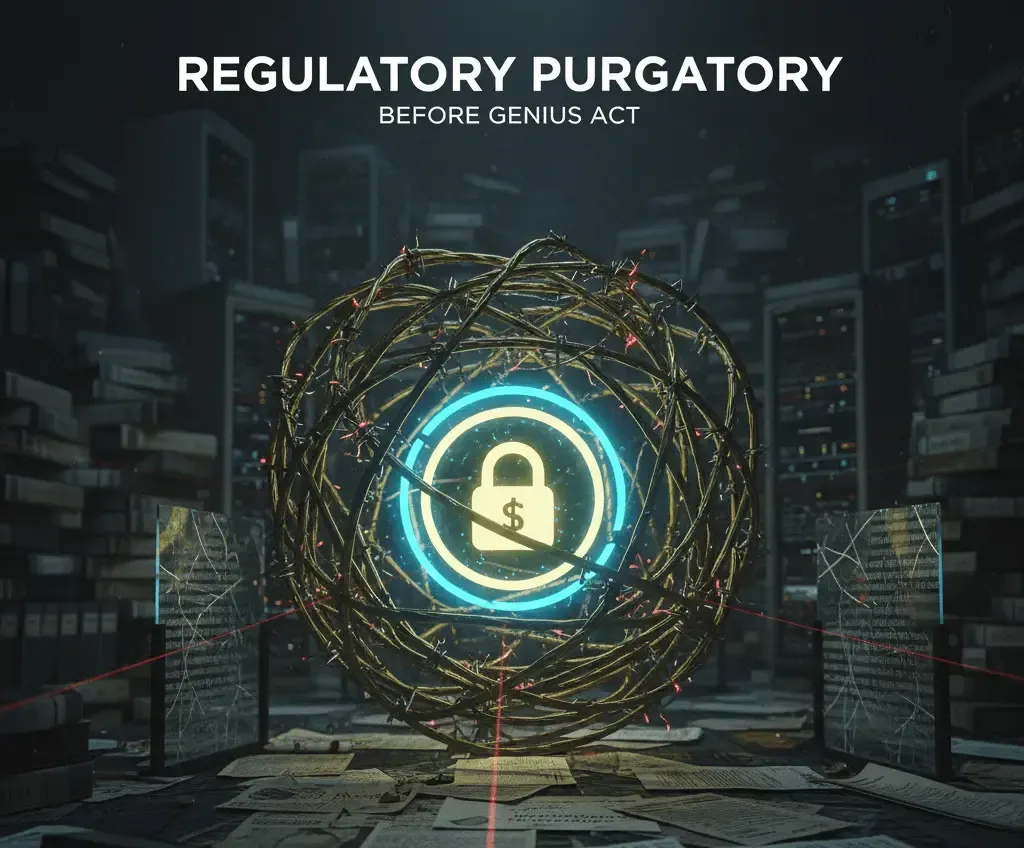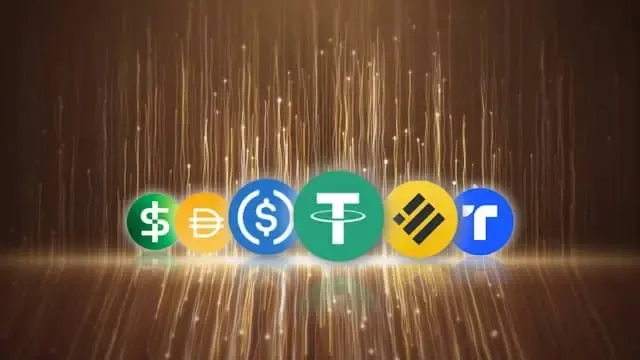The GENIUS Act (and the End of Stablecoin's Marketing Problem?)
We look at how the new GENIUS Act framework opens the door to areas of crypto marketing that have had their hands tied behind their back for years.

For years, stablecoins have been the secret infrastructure holding crypto together:
- They move more daily volume than any other digital asset.
- They're how traders avoid volatility,
- They're how DeFi protocols maintain liquidity,
- And they're how people in countries with unstable currencies actually use crypto for something resembling normal financial activity.
But if you're trying to market stablecoin solutions to anyone outside the existing crypto ecosystem? You've been working with one hand tied behind your back.
That just changed with the GENIUS Act.
In this article from Lever.io, we look at how the GENIUS Act provides a clear regulatory framework for stablecoin integration in the United States. Most importantly, we look at how this new framework opens the door to areas of crypto marketing that have had their hands tied behind their back for years.

What Was Actually Broken with Stablecoin Issuance Before GENIUS
Before the GENIUS Act, stablecoin issuers operated in regulatory purgatory. They weren't banks, but they held billions in customer funds. They weren't securities, but they made investment-like promises about backing and redemption.
State money transmitter licenses provided some oversight, but the patchwork nature meant compliance was expensive and confusing, especially for smaller players trying to compete with Tether and Circle.
More importantly for anyone trying to build legitimate businesses on top of stablecoins, there was no federal standard for what "fully backed" actually meant.
Circle published attestations. Tether published...different things (looking to submit for an audit, eventually).

The gap between "we say we have reserves" and "a federal regulator verified those reserves" was enormous, and that gap killed partnerships before they started.
Try explaining to a CFO why their company should integrate a payment rail where the definition of "backed by dollars" depends on which PowerPoint deck you're reading. Try getting Apple or Google to approve a stablecoin-powered app when there's no clear answer to "what agency oversees this?"
The GENIUS Act didn't emerge from nowhere. Senator Bill Hagerty introduced it in May 2025 as bipartisan legislation, with a companion bill in the House. It passed the Senate 68-30 in June, which was notable because getting 68 senators to agree on anything crypto-related suggested the status quo had become untenable for everyone.
The House passed it in July during what got branded as "Crypto Week," which tells you how much political momentum had built up behind doing something, anything, to clarify the rules.

The New Rules and Why They Matter for Marketing
The core of the GENIUS Act is straightforward: payment stablecoins must be backed 1:1 by actual dollars, Treasury securities, or Federal Reserve balances.
No lending out reserves. No rehypothecation. Monthly public disclosures of what's in the reserve, audited by registered accounting firms. Large issuers, or anyone with more than $50 billion in circulation, get the full treatment with annual GAAP-compliant financial statements.
If this sounds boring. It's not.
Finally Building Trust at Federal Levels
What this means in practice is that federally compliant stablecoins now have something closer to the trust profile of a money market fund than a crypto token.
When Circle or PayPal or whoever else gets federal certification can say, "We're audited under the same standards as a bank, our reserves are segregated and verified monthly, and federal law guarantees you can redeem at par," that's huge.

The redemption piece is huge for consumer-facing messaging. The Act mandates clear redemption policies with disclosed fees and reasonable timelines.
If you're building a remittance app or a payments platform, you can now promise users "you can get your dollars back" without having to add seventeen paragraphs of disclaimers about terms of service and platform risk.
The redemption right is statutory. If an issuer goes bankrupt, stablecoin holders get priority claims on the reserves.
Issuers Can Finally Show Compliance
For brand partnerships and enterprise adoption, the AML and sanctions compliance requirements actually help. Stablecoin issuers are now explicitly treated as financial institutions under the Bank Secrecy Act.
They have to implement customer identification programs, file suspicious activity reports, screen against sanctions lists, and maintain the technical capability to freeze or seize assets under lawful orders.
That last part will bother crypto purists, but it's exactly what corporate compliance departments need to hear. When Starbucks or Nike or whoever is evaluating whether to build loyalty programs on stablecoins, "yes, we can block North Korean hackers and comply with OFAC sanctions" is not a bug.
It's the feature that gets legal to sign off.

The Dual Charter System and What It Unlocks

The Act creates two paths for issuers: state-chartered (for issuers under $10 billion) and federal oversight (for larger players or anyone who wants federal certification).
States can still regulate smaller stablecoin issuers if their rules meet federal standards, certified by a new Stablecoin Certification Review Committee. Larger issuers fall under the OCC, FDIC, or Federal Reserve.
This matters because it preserves room for experimentation while creating a clear path to scale. A fintech startup can launch with a state charter, prove the model works, and graduate to federal oversight as they grow. Regional banks that want to issue stablecoins can do so under state frameworks they already understand.
For marketers, this dual system means the target audience can finally expand beyond "people who already have MetaMask installed." When local credit unions or regional banks can issue stablecoins under state charters, suddenly you have trusted local brands, ones with physical branches and existing customer relationships, able to offer digital dollar accounts that settle on-chain.
That's not a hypothetical future. The regulatory machinery is moving.

How This Changes Web3 Marketing
At Lever, we're excited to provide the layer of trust in crypto between brands who want to run campaigns that reach crypto natives and broad audiences and the creators who have built up audiences on YouTube, X (formerly Twitter), and TikTok.
In a similar way, stablecoins have been given a pathway to build a layer of trust by the U.S., and this is going to change the way Web3 marketing campaigns are run from now on.
The shift from "trust us" to "trust the framework" fundamentally changes how you market anything in Web3 involving stablecoins.
Mainstream payment integrations become possible.
- Before the GENIUS Act, if you wanted to pitch Shopify or Stripe on native stablecoin support, you were asking them to take regulatory risk on an undefined asset class.
- Now you're asking them to support a federally regulated payment method with clear compliance requirements and statutory consumer protections.
Brand partnerships stop being one-offs and start being strategies.
- Companies were already experimenting with crypto rewards and NFT campaigns, but stablecoins were always the awkward middle layer. They enabled the transactions but couldn't be the headline because explaining "blockchain dollar tokens issued by an offshore company" doesn't fit in a Super Bowl ad.
- When Circle or PayPal can say their stablecoin is federally regulated and backed by segregated reserves audited monthly, brands can message around stablecoins directly. Loyalty points that convert to USDC. Refunds issued in PayPal USD. Cross-border payments for global community members.
Performance marketing opens up.
- Google and Meta have always been conservative about crypto advertising because the regulatory uncertainty made it hard to distinguish where the line was drawn. Federal oversight provides a bright line.
- Federally compliant stablecoins can probably get approved for ad campaigns that would never have flown before. That means retargeting, conversion optimization, all the normal growth tools that Web3 projects have mostly been locked out of for years.
The B2B sales cycle shortens dramatically.
- Enterprise crypto deals have involved months of legal review, custom risk assessments, and usually a final "let's wait and see" from someone senior.
- When you're selling infrastructure built on federally regulated stablecoins, the legal review still happens, but it looks like evaluating any other fintech vendor.
- You're not asking them to be crypto pioneers. You're asking them to use a payment method that happens to settle on a blockchain.

What Happens Next: The Way of DeFi Early(ish) Adopters vs. TradFi Entrants

The immediate opportunity is for Circle. USDC already meets most of the Act's requirements, including a 1:1 backing, monthly attestations, and strong compliance programs.
Federal certification is more of a formality than a transformation. That means Circle can move fast on partnerships that were pending regulatory clarity. Expect announcements with major payments platforms, banking integrations, and enterprise deals that have been sitting in legal review for months.
PayPal is positioned similarly. PYUSD launched with a state trust charter and transparent reserves. The Act essentially validates their model and gives them a clearer path to scale.
PayPal has distribution advantages most crypto companies can't match, like hundreds of millions of existing users who already trust the brand for payments. If they push hard on stablecoin integration within the PayPal app, that could mainstream stablecoins faster than anything else.
Traditional banks are the wild card. Regional banks and credit unions now have a defined path to issue stablecoins without becoming crypto companies. Some will absolutely do this, especially banks serving communities with high remittance use or businesses dealing with cross-border payments.
When your local bank offers a digital dollar account that settles instantly on-chain, stablecoins stop being a crypto thing and start being a banking product.
For Web3 marketing teams, the next 12 months are about picking your lane.
Digital assets are about to go mainstream in a big way, and if you've been working in Web3 for the last few years, you know that projects have either been living in fear of regulatory certainty (mostly in the USA) or programming full-steam ahead (mostly outside the USA).
- If you're building for mainstream adoption, lean into the regulatory framework hard. Make federal compliance and reserve transparency central to your messaging. Target partnerships with established brands and traditional financial institutions. Optimize for trust signals over decentralization credibility.
- If you're building for the true believers, don't pretend compliance is your priority. Be explicit about the tradeoffs you're making and why censorship resistance matters more than institutional partnerships. Market to people who value those properties and will accept the limitations that come with them.
- The middle ground is going to be uncomfortable. You can't message to enterprise clients about regulatory compliance and simultaneously promise DeFi users that funds are unstoppable. Pick one.
Whichever route your team takes, hiring crypto KOLs through Lever.io ensures you're outreach doesn't include botted creators, everything is handled by professionals with years of experience in the industry, and you're messaging won't cross the line while points are publicly made about your project.

The Dollar Finally Goes Mainstream On-Chain

The weird geopolitical subtext of all this: the GENIUS Act effectively turns stablecoins into a private-sector extension of U.S. dollar dominance.
Every federally compliant stablecoin is ultimately backed by U.S. Treasuries or dollars held in U.S. banks. Every transaction reinforces demand for dollar-denominated assets.
For people in countries with volatile currencies or restricted capital controls, stablecoins become the easiest way to access dollars without going through traditional banking systems.
That's huge for American soft power. The U.S. gets to export its currency globally without issuing a central bank digital currency, which remains politically toxic.
From a marketing perspective, this creates permission to message stablecoins as infrastructure for the global economy, not just crypto speculation. The use case isn't "number go up." It's "reliable money for people who don't have it."
That's a message that works outside Crypto Twitter.
The GENIUS Act doesn't solve every problem with stablecoin marketing. It doesn't make the technology less confusing for regular users. It doesn't fix gas fees or the UX disaster of wallet management. But it removes the fundamental trust barrier that has kept stablecoins niche despite their obvious utility.
When your pitch stops being "trust this opaque offshore company" and starts being "federally regulated, audited monthly, statutory redemption rights," you can finally have normal marketing conversations.
- You can run ads.
- You can pitch Fortune 500 companies.
- You can explain the value proposition without spending twenty minutes on regulatory disclaimers.
That's not the end of Web3 marketing challenges. But it's the end of the one that's been killing deals for years.
Run Next Generation Crypto Campaigns with Lever Trust & Insight

Now that the regulatory foundation is set, the companies that move fast on creator partnerships and influencer campaigns will own the next wave of mainstream adoption.
The hard part will always be managing KOLs at scale without burning budget on flaky deliverables and campaign chaos.
That's exactly what Lever handles. We connect you with vetted Web3 creators on crypto's biggest platforms, manage the entire campaign workflow, and make sure you actually get what you paid for.
- No chasing down posts.
- No surprise rate hikes.
- No dealing with 47 different DMs to coordinate a single campaign.
- Just results.
If you're ready to capitalize on stablecoin legitimacy and reach real users instead of just other crypto people, talk to us. We'll handle the creator headaches so you can focus on the message.






